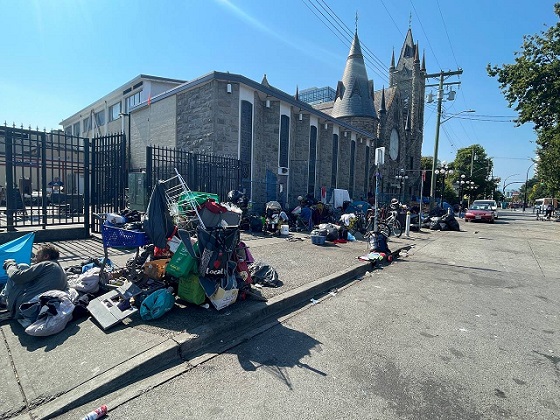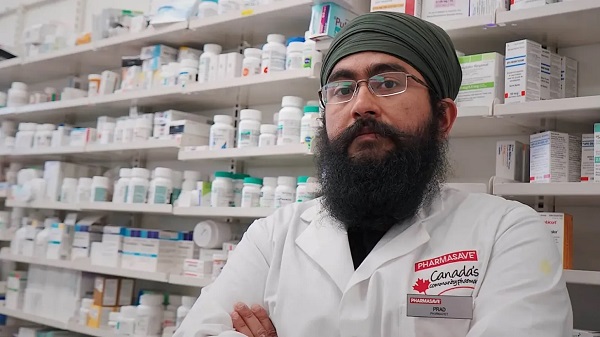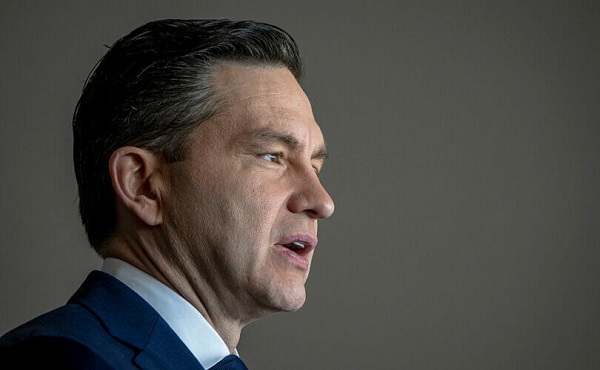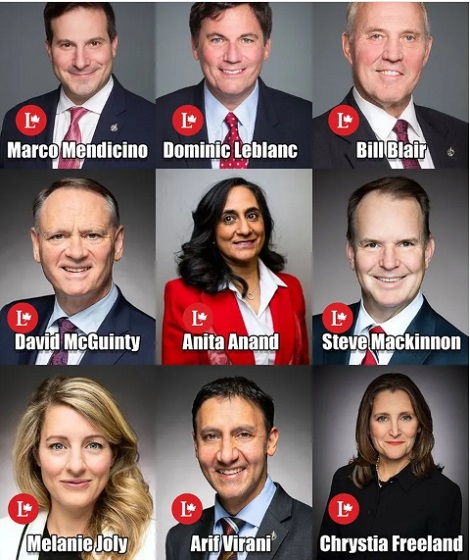Addictions
B.C. mayors voice discontent over province’s response to drug crisis

The street outside the Harbour Supervised Consumption Service in Victoria, B.C., on Sept. 6, 2024. (Photo credit: Alexandra Keeler)
By Alexandra Keeler
A number of B.C. mayors say the province’s drug decriminalization project has been a failure — and they are not confident involuntary care will address the problem
Many B.C. mayors are unhappy with the province’s handling of the drug crisis, saying it is failing their communities.
“I don’t think [the province’s] approach was very well thought out,” said Mayor Brad West of Port Coquitlam, a city of 61,000 that is a half-hour’s drive east of Vancouver.
“They announced, seemingly pretty quickly, that the province was going to pursue decriminalization, and there didn’t seem to be a lot of public discourse or consultation in the lead up to it,” he said.
“It was just kind of like, ‘Bam! Here it is.’”
West’s comments were echoed by other municipal leaders, who also say the province’s harm-reduction and treatment services are under-resourced, leaving them ill-equipped to help community members who are struggling.
‘Can’t do anything’
West says he and Port Coquitlam’s constituents observed an immediate increase in public drug use after the province launched a three-year, trial decriminalization project in January 2023.
The project initially enabled residents to use otherwise illicit drugs — such as fentanyl, heroin and cocaine — in most parts of the province, although it prohibited drug use on school premises or near child-care facilities.
Yet, West says drug use in parks and playgrounds was a major issue in his community.
“What [decriminalization] meant in a place like Port Coquitlam is that when you did have an incident that required a police response, none was forthcoming anymore,” he said. “[Police] would tell you, ‘Well, we can’t do anything. We’re not allowed to.’”
In June 2023, Port Coquitlam responded by passing a bylaw, introduced by West, that banned drug use in public spaces. Other B.C. municipalities — including Nelson, Kamloops and Campbell River — soon followed suit.
In December, B.C. tried to pass a law enabling police to remove people from public spaces if they were using drugs. But a B.C. court temporarily blocked it, citing risks to drug users.
The province then sought approval from Ottawa to re-criminalize public drug use, which it obtained this spring. Now, hard drug use is only permitted in private residences, legal shelters or harm-reduction clinics.
Subscribe for free to get BTN’s latest news and analysis, or donate to our journalism fund.
Wait times
West says he has also been frustrated with the province’s harm-reduction facilities, which he describes as “poorly staffed” and “under-resourced.” These facilities often fail to connect individuals to necessary resources or recovery programs, he says.
West has witnessed some of these problems up close. His stepbrother battled addiction and homelessness before finding recovery.
“The biggest barrier that I think he encountered — and most people encounter in terms of recovery — is the wait times,” he said.
The wait time to get into B.C.’s private addiction rehab centres is about three to seven days. But the cost — ranging from $10,000 to $30,000 a month — is out of reach for many.
By contrast, the wait time to get into government-funded programs is about three to six months.
In addition to advocating for more accessible recovery services, West emphasizes the need for stronger enforcement at docks, ports and borders to combat drug trafficking.
“Our ports of entry, our border, the port itself, are completely porous,” he said. “We have no dedicated port police — one of the few jurisdictions that doesn’t. And as a result, Metro Vancouver has become an epicentre for drug trafficking.”
In May 2023, he was the sole Canadian mayor invited by US Secretary of State Antony Blinken to discuss the issue with other mayors. “We have weak [drug] laws … This is why I think we’ve become a global hub for [drug trafficking],” he said.
Brain damage
The BC NDP and BC Conservatives have both recently pledged to introduce involuntary care, which would enable the province to admit people with addiction challenges, brain injuries and mental-health issues into treatment facilities without their consent.
Mayor Leonard Krog of Nanaimo, a coastal city of about 100,000 on the east side of Vancouver Island, has long advocated for involuntary care.
 |
Nanaimo Mayor Leonard Krog sits in his office at Nanaimo City Hall on Sept. 4, 2024. (Photo credit: Alexandra Keeler)
Krog notes that a significant segment of the homeless population has suffered brain damage, which can exacerbate efforts to help them. A 2020 report by Brain Injury Canada says about 50 per cent of people experiencing homelessness have some form of brain injury.
Krog does not believe people with brain injuries and addiction issues are likely to seek treatment on their own. “Those folks should be in secure, involuntary care,” he said.
But he is not optimistic that NDP’s involuntary care proposal will address the full scope of the issue.
“[I]n terms of numbers, my strong view is that it will not address the significant population who are currently in the streets.”
Stay alive
Victoria Mayor Marianne Alto believes in providing support to keep people alive until they seek recovery.
“My view of harm reduction is … I’ll give you anything you need to stay alive until you have that epiphany moment,” she said.
But she is concerned that the province has not adopted a comprehensive approach to tackling the drug crisis. The recent proposals to introduce involuntary care have not eased her concerns.
“Involuntary care can be a necessary tool in a complex system,” she said. “But its effectiveness hinges on clear standards. We must ensure that individuals receive not just initial intervention but also ongoing support to prevent their return to the circumstances that led them there.”
“The devil is in the details,” she said.
 |
Victoria Mayor Marianne Alto leans against a railing in downtown Victoria, B.C. , in May 2022. (Marianne Alto’s Facebook)
The B.C. capital has been pursuing additional strategies to tackle the city’s homelessness, addiction and mental health challenges.
For example, a local nonprofit has been working with individuals living in parks to connect them with housing and support. “It’s also very slow, because to be very successful, you have to do it one person at a time, one-on-one. But it’s working,” she said.
But other efforts have met resistance.
City council rejected a motion introduced by Alto that had proposed rewarding churches and cultural centres that offered overnight parking to vehicle-dwelling homeless people. Five council members opposed it, Alto says, citing fears about crime and concerns that the program overstepped their duties.
“There is a genuine fatigue in the public, which is being reflected in municipal councils, saying, ‘How much further, how much longer, how much more?’”
This article was produced through the Breaking Needles Fellowship Program, which provided a grant to Canadian Affairs, a digital media outlet, to fund journalism exploring addiction and crime in Canada. Articles produced through the Fellowship are co-published by Break The Needle and Canadian Affairs.
You’re currently a free subscriber to Break The Needle. Our content is always free – but if you want to help us commission more high-quality journalism, consider getting a voluntary paid subscription.
2025 Federal Election
Study links B.C.’s drug policies to more overdoses, but researchers urge caution

By Alexandra Keeler
A study links B.C.’s safer supply and decriminalization to more opioid hospitalizations, but experts note its limitations
A new study says B.C.’s safer supply and decriminalization policies may have failed to reduce overdoses. Furthermore, the very policies designed to help drug users may have actually increased hospitalizations.
“Neither the safer opioid supply policy nor the decriminalization of drug possession appeared to mitigate the opioid crisis, and both were associated with an increase in opioid overdose hospitalizations,” the study says.
The study has sparked debate, with some pointing to it as proof that B.C.’s drug policies failed. Others have questioned the study’s methodology and conclusions.
“The question we want to know the answer to [but cannot] is how many opioid hospitalizations would have occurred had the policy not have been implemented,” said Michael Wallace, a biostatistician and associate professor at the University of Waterloo.
“We can never come up with truly definitive conclusions in cases such as this, no matter what data we have, short of being able to magically duplicate B.C.”
Jumping to conclusions
B.C.’s controversial safer supply policies provide drug users with prescription opioids as an alternative to toxic street drugs. Its decriminalization policy permitted drug users to possess otherwise illegal substances for personal use.
The peer-reviewed study was led by health economist Hai Nguyen and conducted by researchers from Memorial University in Newfoundland, the University of Manitoba and Weill Cornell Medicine, a medical school in New York City. It was published in the medical journal JAMA Health Forum on March 21.
The researchers used a statistical method to create a “synthetic” comparison group, since there is no ideal control group. The researchers then compared B.C. to other provinces to assess the impact of certain drug policies.
Examining data from 2016 to 2023, the study links B.C.’s safer supply policies to a 33 per cent rise in opioid hospitalizations.
The study says the province’s decriminalization policies further drove up hospitalizations by 58 per cent.
“Neither the safer supply policy nor the subsequent decriminalization of drug possession appeared to alleviate the opioid crisis,” the study concludes. “Instead, both were associated with an increase in opioid overdose hospitalizations.”
The B.C. government rolled back decriminalization in April 2024 in response to widespread concerns over public drug use. This February, the province also officially acknowledged that diversion of safer supply drugs does occur.
The study did not conclusively determine whether the increase in hospital visits was due to diverted safer supply opioids, the toxic illicit supply, or other factors.
“There was insufficient evidence to conclusively attribute an increase in opioid overdose deaths to these policy changes,” the study says.
Nguyen’s team had published an earlier, 2024 study in JAMA Internal Medicine that also linked safer supply to increased hospitalizations. However, it failed to control for key confounders such as employment rates and naloxone access. Their 2025 study better accounts for these variables using the synthetic comparison group method.
The study’s authors did not respond to Canadian Affairs’ requests for comment.
Subscribe for free to get BTN’s latest news and analysis – or donate to our investigative journalism fund.
Correlation vs. causation
Chris Perlman, a health data and addiction expert at the University of Waterloo, says more studies are needed.
He believes the findings are weak, as they show correlation but not causation.
“The study provides a small signal that the rates of hospitalization have changed, but I wouldn’t conclude that it can be solely attributed to the safer supply and decrim[inalization] policy decisions,” said Perlman.
He also noted the rise in hospitalizations doesn’t necessarily mean more overdoses. Rather, more people may be reaching hospitals in time for treatment.
“Given that the [overdose] rate may have gone down, I wonder if we’re simply seeing an effect where more persons survive an overdose and actually receive treatment in hospital where they would have died in the pre-policy time period,” he said.
The Nguyen study acknowledges this possibility.
“The observed increase in opioid hospitalizations, without a corresponding increase in opioid deaths, may reflect greater willingness to seek medical assistance because decriminalization could reduce the stigma associated with drug use,” it says.
“However, it is also possible that reduced stigma and removal of criminal penalties facilitated the diversion of safer opioids, contributing to increased hospitalizations.”
Karen Urbanoski, an associate professor in the Public Health and Social Policy department at the University of Victoria, is more critical.
“The [study’s] findings do not warrant the conclusion that these policies are causally associated with increased hospitalization or overdose,” said Urbanoski, who also holds the Canada Research Chair in Substance Use, Addictions and Health Services.
Her team published a study in November 2023 that measured safer supply’s impact on mortality and acute care visits. It found safer supply opioids did reduce overdose deaths.
Critics, however, raised concerns that her study misrepresented its underlying data and showed no statistically significant reduction in deaths after accounting for confounding factors.
The Nguyen study differs from Urbanoski’s. While Urbanoski’s team focused on individual-level outcomes, the Nguyen study analyzed broader, population-level effects, including diversion.
Wallace, the biostatistician, agrees more individual-level data could strengthen analysis, but does not believe it undermines the study’s conclusions. Wallace thinks the researchers did their best with the available data they had.
“We do not have a ‘copy’ of B.C. where the policies weren’t implemented to compare with,” said Wallace.
B.C.’s overdose rate of 775 per 100,000 is well above the national average of 533.
Elenore Sturko, a Conservative MLA for Surrey-Cloverdale, has been a vocal critic of B.C.’s decriminalization and safer supply policies.
“If the government doesn’t want to believe this study, well then I invite them to do a similar study,” she told reporters on March 27.
“Show us the evidence that they have failed to show us since 2020,” she added, referring to the year B.C. implemented safer supply.
This article was produced through the Breaking Needles Fellowship Program, which provided a grant to Canadian Affairs, a digital media outlet, to fund journalism exploring addiction and crime in Canada. Articles produced through the Fellowship are co-published by Break The Needle and Canadian Affairs.
Our content is always free – but if you want to help us commission more high-quality journalism,
consider getting a voluntary paid subscription.
Addictions
Addiction experts demand witnessed dosing guidelines after pharmacy scam exposed

By Alexandra Keeler
The move follows explosive revelations that more than 60 B.C. pharmacies were allegedly participating in a scheme to overbill the government under its safer supply program. The scheme involved pharmacies incentivizing clients to fill prescriptions they did not require by offering them cash or rewards. Some of those clients then sold the drugs on the black market.
An addiction medicine advocacy group is urging B.C. to promptly issue new guidelines for witnessed dosing of drugs dispensed under the province’s controversial safer supply program.
In a March 24 letter to B.C.’s health minister, Addiction Medicine Canada criticized the BC Centre on Substance Use for dragging its feet on delivering the guidelines and downplaying the harms of prescription opioids.
The centre, a government-funded research hub, was tasked by the B.C. government with developing the guidelines after B.C. pledged in February to return to witnessed dosing. The government’s promise followed revelations that many B.C. pharmacies were exploiting rules permitting patients to take safer supply opioids home with them, leading to abuse of the program.
“I think this is just a delay,” said Dr. Jenny Melamed, a Surrey-based family physician and addiction specialist who signed the Addiction Medicine Canada letter. But she urged the centre to act promptly to release new guidelines.
“We’re doing harm and we cannot just leave people where they are.”
Addiction Medicine Canada’s letter also includes recommendations for moving clients off addictive opioids altogether.
“We should go back to evidence-based medicine, where we have medications that work for people in addiction,” said Melamed.
‘Best for patients’
On Feb. 19, the B.C. government said it would return to a witnessed dosing model. This model — which had been in place prior to the pandemic — will require safer supply participants to take prescribed opioids under the supervision of health-care professionals.
The move follows explosive revelations that more than 60 B.C. pharmacies were allegedly participating in a scheme to overbill the government under its safer supply program. The scheme involved pharmacies incentivizing clients to fill prescriptions they did not require by offering them cash or rewards. Some of those clients then sold the drugs on the black market.
In its Feb. 19 announcement, the province said new participants in the safer supply program would immediately be subject to the witnessed dosing requirement. For existing clients of the program, new guidelines would be forthcoming.
“The Ministry will work with the BC Centre on Substance Use to rapidly develop clinical guidelines to support prescribers that also takes into account what’s best for patients and their safety,” Kendra Wong, a spokesperson for B.C.’s health ministry, told Canadian Affairs in an emailed statement on Feb. 27.
More than a month later, addiction specialists are still waiting.
According to Addiction Medicine Canada’s letter, the BC Centre on Substance Use posed “fundamental questions” to the B.C. government, potentially causing the delay.
“We’re stuck in a place where the government publicly has said it’s told BCCSU to make guidance, and BCCSU has said it’s waiting for government to tell them what to do,” Melamed told Canadian Affairs.
This lag has frustrated addiction specialists, who argue the lack of clear guidance is impeding the transition to witnessed dosing and jeopardizing patient care. They warn that permitting take-home drugs leads to more diversion onto the streets, putting individuals at greater risk.
“Diversion of prescribed alternatives expands the number of people using opioids, and dying from hydromorphone and fentanyl use,” reads the letter, which was also co-signed by Dr. Robert Cooper and Dr. Michael Lester. The doctors are founding board members of Addiction Medicine Canada, a nonprofit that advises on addiction medicine and advocates for research-based treatment options.
“We have had people come in [to our clinic] and say they’ve accessed hydromorphone on the street and now they would like us to continue [prescribing] it,” Melamed told Canadian Affairs.
A spokesperson for the BC Centre on Substance Use declined to comment, referring Canadian Affairs to the Ministry of Health. The ministry was unable to provide comment by the publication deadline.
Big challenges
Under the witnessed dosing model, doctors, nurses and pharmacists will oversee consumption of opioids such as hydromorphone, methadone and morphine in clinics or pharmacies.
The shift back to witnessed dosing will place significant demands on pharmacists and patients. In April 2024, an estimated 4,400 people participated in B.C.’s safer supply program.
Chris Chiew, vice president of pharmacy and health-care innovation at the pharmacy chain London Drugs, told Canadian Affairs that the chain’s pharmacists will supervise consumption in semi-private booths.
Nathan Wong, a B.C.-based pharmacist who left the profession in 2024, fears witnessed dosing will overwhelm already overburdened pharmacists, creating new barriers to care.
“One of the biggest challenges of the retail pharmacy model is that there is a tension between making commercial profit, and being able to spend the necessary time with the patient to do a good and thorough job,” he said.
“Pharmacists often feel rushed to check prescriptions, and may not have the time to perform detailed patient counselling.”
Others say the return to witnessed dosing could create serious challenges for individuals who do not live close to health-care providers.
Shelley Singer, a resident of Cowichan Bay, B.C., on Vancouver Island, says it was difficult to make multiple, daily visits to a pharmacy each day when her daughter was placed on witnessed dosing years ago.
“It was ridiculous,” said Singer, whose local pharmacy is a 15-minute drive from her home. As a retiree, she was able to drive her daughter to the pharmacy twice a day for her doses. But she worries about patients who do not have that kind of support.
“I don’t believe witnessed supply is the way to go,” said Singer, who credits safer supply with saving her daughter’s life.
Melamed notes that not all safer supply medications require witnessed dosing.
“Methadone is under witness dosing because you start low and go slow, and then it’s based on a contingency management program,” she said. “When the urine shows evidence of no other drug, when the person is stable, [they can] take it at home.”
She also noted that Suboxone, a daily medication that prevents opioid highs, reduces cravings and alleviates withdrawal, does not require strict supervision.
Kendra Wong, of the B.C. health ministry, told Canadian Affairs that long-acting medications such as methadone and buprenorphine could be reintroduced to help reduce the strain on health-care professionals and patients.
“There are medications available through the [safer supply] program that have to be taken less often than others — some as far apart as every two to three days,” said Wong.
“Clinicians may choose to transition patients to those medications so that they have to come in less regularly.”
Such an approach would align with Addiction Medicine Canada’s recommendations to the ministry.
The group says it supports supervised dosing of hydromorphone as a short-term solution to prevent diversion. But Melamed said the long-term goal of any addiction treatment program should be to reduce users’ reliance on opioids.
The group recommends combining safer supply hydromorphone with opioid agonist therapies. These therapies use controlled medications to reduce withdrawal symptoms, cravings and some of the risks associated with addiction.
They also recommend limiting unsupervised hydromorphone to a maximum of five 8 mg tablets a day — down from the 30 tablets currently permitted with take-home supplies. And they recommend that doses be tapered over time.
“This protocol is being used with success by clinicians in B.C. and elsewhere,” the letter says.
“Please ensure that the administrative delay of the implementation of your new policy is not used to continue to harm the public.”
This article was produced through the Breaking Needles Fellowship Program, which provided a grant to Canadian Affairs, a digital media outlet, to fund journalism exploring addiction and crime in Canada. Articles produced through the Fellowship are co-published by Break The Needle and Canadian Affairs.
Subscribe to Break The Needle
-

 2025 Federal Election2 days ago
2025 Federal Election2 days agoThe Anhui Convergence: Chinese United Front Network Surfaces in Australian and Canadian Elections
-

 2025 Federal Election1 day ago
2025 Federal Election1 day agoPoilievre Campaigning To Build A Canadian Economic Fortress
-

 Automotive1 day ago
Automotive1 day agoCanadians’ Interest in Buying an EV Falls for Third Year in a Row
-

 2025 Federal Election2 days ago
2025 Federal Election2 days agoTrump Has Driven Canadians Crazy. This Is How Crazy.
-

 2025 Federal Election2 days ago
2025 Federal Election2 days agoCarney Liberals pledge to follow ‘gender-based goals analysis’ in all government policy
-

 2025 Federal Election2 days ago
2025 Federal Election2 days agoPoilievre’s Conservatives promise to repeal policy allowing male criminals in female jails
-

 conflict2 days ago
conflict2 days agoTrump tells Zelensky: Accept peace or risk ‘losing the whole country’
-

 Automotive1 day ago
Automotive1 day agoHyundai moves SUV production to U.S.






